Recent headlines read “Nearly 5,000 Units of Housing on the Fast Track,” “Public Gets First Glimpse into Massive Housing Project Planned for La Cumbre Plaza,” and “How Santa Barbara City Hall Deep-Sixed Its 60-Foot Height Limit.” While these headlines may grab attention, they fail to reflect the important story — that of a housing crisis. Here we explain the seriousness of our housing shortage, how we got here and why infill housing is critical to the health of our community. We hope local media includes this critical story in its coverage of housing projects.
Why Housing Development Matters
South Coast housing is increasingly unaffordable. Median home prices (presently in excess of $2 million in the City of Santa Barbara) have more than doubled in nearly all jurisdictions since 2012, while vacancy rates have decreased 40 percent to 1.1 percent. These skyrocketing prices and lack of housing supply are shocking when compared to average median income — $107,300 for a family of four.
Despite these glaring numbers, many (who may be lucky enough to have secure housing) do not see the need for more. That is shortsighted. Santa Barbara County Association of Governments (SBCAG) reports the population of middle-age people — those ages 30-49 — has decreased significantly in the past decade. This weakens our community and impacts the climate; SBCAG finds that 30 percent of work commutes destined for the City of Santa Barbara and (and 43 percent destined for Goleta) travel greater than 16 miles. It impacts vital essential workers, with 23 percent of Cottage Hospital workers commuting from outside the county. Providing affordable housing for the 11,100 daily commuters from Ventura is a key way we can achieve our lofty climate goals, preserve our local economy, and support families.
How We Got Here
It is no secret there has been a lack of housing development on the South Coast over the past several decades. Our local jurisdictions acknowledge as much.
Every eight years, the state and SBCAG determine how much housing is needed within each county municipality. This process is called the Regional Housing Needs Allocation (RHNA), and it kickstarts the update to each agency’s housing element, a document that shows how the local government will plan for housing to meet existing and expected demand.
South Coast jurisdictions have largely failed to permit the development of the housing contemplated in their housing elements. The last cycle tells the story. From 2015 to 2023, the cities of Santa Barbara and Goleta only produced 17 percent of the lower-income units and 3 percent of the moderate-income units identified in their RHNA. This shortfall equates to 2,326 additional affordable units needed to meet present demand.
This current housing element cycle (2023–2031) poses a daunting task. The new RHNA allocation requires the cities of Santa Barbara, Goleta, and the county to plan for 13,980 new units — including 6,300 lower-income and 2,862 moderate-income units. Can these jurisdictions shirk past practice and permit new housing sufficient to meet demand? The jury is still out, so the state has a say.
How State Law Incentives New Housing
Given the failure by local agencies to permit housing, the state has removed local barriers to development and offered incentives to developers to build affordable housing. These provisions are necessary due to rising costs in land and construction and protracted local approval processes that render development nearly infeasible, especially at affordable price points.
Local headlines have taken aim at two provisions of state housing law — the Builder’s Remedy and Density Bonus Law. The Builder’s Remedy prohibits a city or county from denying housing developments based on an inconsistency with the general plan or zoning ordinance. However, the Builder’s Remedy only applies if: (1) the development provides 20 percent of its units for lower income or 100 percent for moderate income; and (2) the city or county failed to adopt a housing element in substantial compliance with state law. All South Coast jurisdictions were due to update their housing elements for this cycle in February 2023, but all failed to do so. This opened the door for Builder’s Remedy.
Similarly, the Density Bonus Law (also state law since 1979) allows qualifying projects to increase density based on its proportion of affordable units. For example, if a project includes 10 percent lower-income units, it is granted a 20 percent density bonus. Developers may receive a larger bonus or additional concessions by providing a higher percentage of affordable units. The law also allows developers to request waivers of certain standards (e.g., height restrictions, setback requirements) historically used by local governments to preclude denser, more affordable housing.
Importantly, these state housing laws ease local barriers to development that are at the root of the crisis. Without provisions like these, projects do not pencil out. It is no surprise that the La Cumbre Macy’s redevelopment (otherwise known as the “Massive Housing Project” in local coverage) opted to use the Density Bonus Law.
We highlight these facts to urge local media to responsibly craft narratives that reflect the context of our housing issues — instead of sensational headlines that may generate more clicks yet reinforce an unsustainable status quo.
The views expressed are solely those of the authors and do not necessarily reflect that of their employer.

